Index

Review: Quiet, great performance, great holiday gift
Putting the same GPU used in GTX 580 to good use, the GTX 570 is 25% faster on average than the not-so-popular GTX 470, but that is not all this card is capable of. In fact, the GTX 570 packs enough punch to beat the HD 5870 and even the GTX 480.
We’re talking about a card based on the GF110, currently the fastest GPU on the market. Compared to its more powerful sibling, GTX 570`s arsenal is somewhat weaker. The new card has one cluster less totaling at 480 shaders, instead of 512 shaders on GTX 580. The GTX 570 sports 40 ROPs, 60 texture units and 320-bit memory interface. In comparison, the GTX 580 comes with 48 ROPs, 64 texture units, and 384-bit memory interface whereas the GTX 480 has 48 ROPs, 60 texture units and 384-bit memory interface.
Thanks to the same number of shaders and higher clocks, the GTX 570 offers improved performance at better power/thermals compared to the GTX 480. Furthermore, all this now comes at a lower price, which is something that many Nvidians should look forward to.
The Geforce GTX 570 boasts 732MHz for the GPU, 1464MHz for the shaders and 950MHz for the memory (3800MHz effectively). The card has 1280MB of GDDR5 memory paired up with a 320-bit bus. It has two 6-pin power connectors and 219W TDP compared to 244W TDP on GTX 580.
The GTX 570 retained the vapor chamber cooling used on GTX 580 cards, and we must admit that we like it as it’s quiet and efficient. 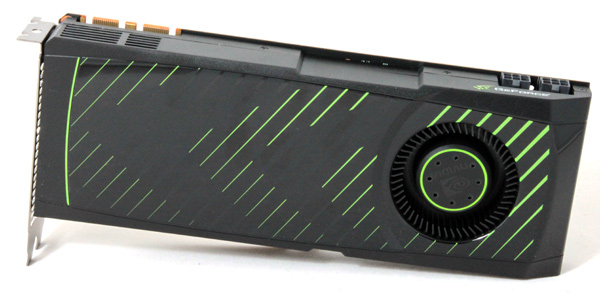
A closer look at the GTX 570
When it comes to performance and thermals, reference dual slot cooling on the GTX 580 ended up being much better compared to the GTX 480’s. Nvidia basically took the GTX 580’s cooling and added few design touches in order to provide the GTX 570 with efficient cooling. With help from the vapor chamber, the GTX 570`s cooler is really quiet. Note that the GTX 580 and GTX 570 loos the same at a glance, with only a small difference in the texture.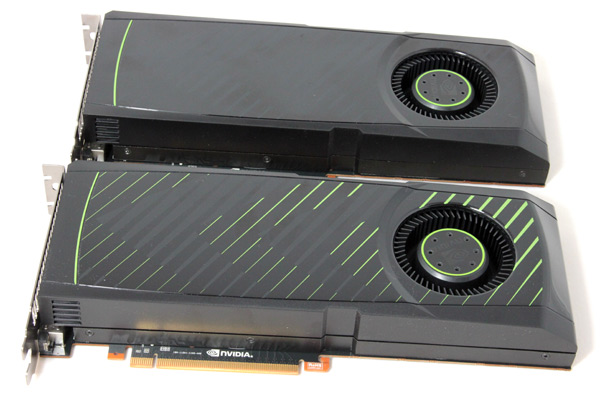
The plastic hood covers the entire card and all that’s visible is the blower-style fan, which exhausts hot air out the back of the system chassis. GTX 580 and 570 also feature a new adaptive GPU fan control algorithm that smoothes the ramp up/down of the fan speed under load.
GTX 580 and GTX 570 employ copper vapor chamber technology that draws heat off of the GPU. The heat is then dissipated by a large, dual slot heatsink. The GTX 570 has a bit larger dissipational surface compared to GTX 580.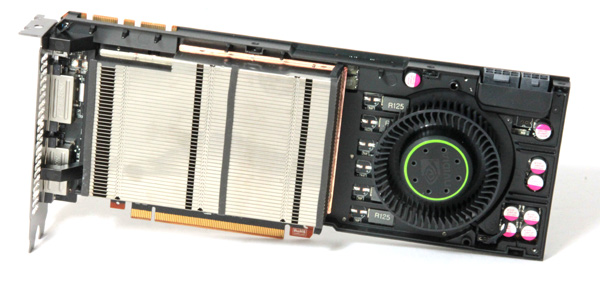
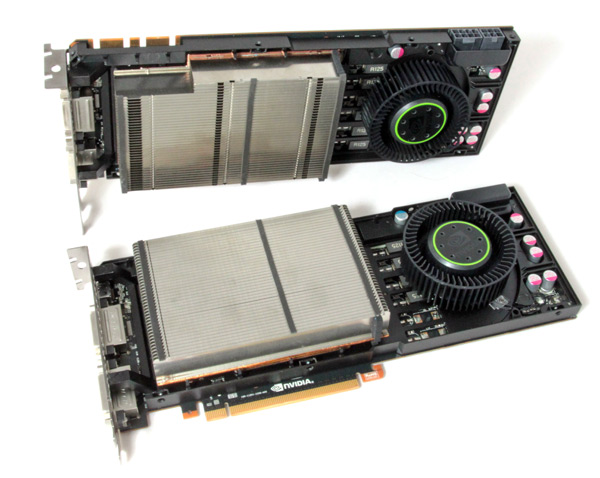
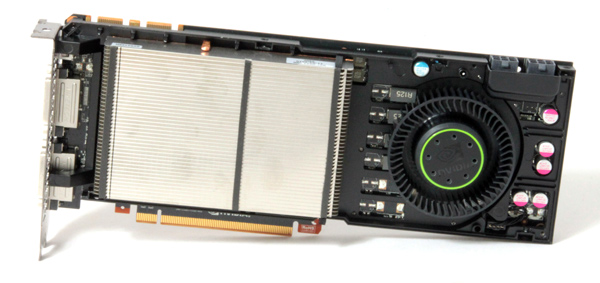
Unlike the long heatpipes which transfer heat from copper base to aluminum fins for dissipation, the Vapor-X chamber is a component that brings both copper-base and heatpipe functions together. The advantage is in direct contact with the GPU and a large surface of only a few millimeters thick Vapor-X chamber, which comes in place of a copper base. It then directly receives and transfers heat to the aluminum fins. Note that despite the performance improvements, visual inspection won’t show much difference between Vapor-X chamber cooling and standard cooling solutions with a copper base.
Built from the same DNA as the GTX 580, the GTX 570 incorporates all the enhancements found in its more powerful sibling. GTX 580/570’s PCB design hasn’t changed much from the GTX 480, but there have been improvements in power regulation circuitry. Nvidia added Advanced Power Management, a feature which monitors consumption and performs power capping – all to protect the graphics cards from excessive power draw and potentially resulting damage. 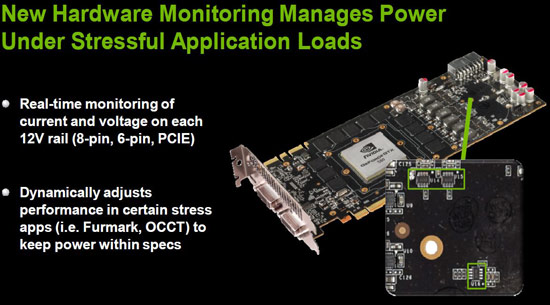
The GTX 570 has 4-phase power whereas the GTX 580 comes with 6 phases. As you can see from the picture below, the GTX 570 lacks two power phases when compared to the GTX 580.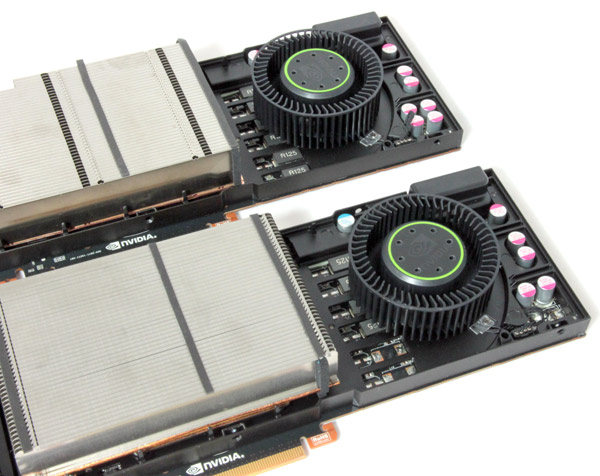
GTX 580/570 is the same size as Geforce GTX 480, measuring 10.5 inches or 26.7 centimeters in length. GTX 570 has two 6-pin power connectors maximum graphics card power 219W compared to GTX 580 which has one 6-pin and 8-pin power connector and maximum graphics card power 244W.
The video engine didn’t change, it is the same as on GF100, Fermi chips. You still have maximum of two display supported and no DisplayPort, at least not on reference boards. The reference card has two dual-link DVI ports and one mini HDMI. The mini HDMI cable might be bundled by partners and if not it will cost you much more than a standard full size HDMI that you use for your HD TV.

Testbed
Motherboard: EVGA 4xSLI
CPU: Core i7 965 XE (Intel EIST and Vdrop enabled)
Memory: 6GB Corsair Dominator 12800 7-7-7-24
Harddisk: OCZ Vertex 2 100 GB
Power Supply: CoolerMaster Silent Pro Gold 800W
Case: CoolerMaster HAF X
Fan Controler: Kaze Master Pro 5.25"
Operating System: Win7 64-bit
263.09_desktop_win7_winvista_64bit
10.11 CCC / catalyst_10.10e_hotfix_win7_nov9
3DMark 2011
3DMark 11 is the latest version of the popular benchmark for measuring the 3D graphics performance of gaming PCs. 3DMark 11 uses a native DirectX 11 engine which makes extensive use of all the new features in DirectX 11 including tessellation, compute shaders and multi-threading.
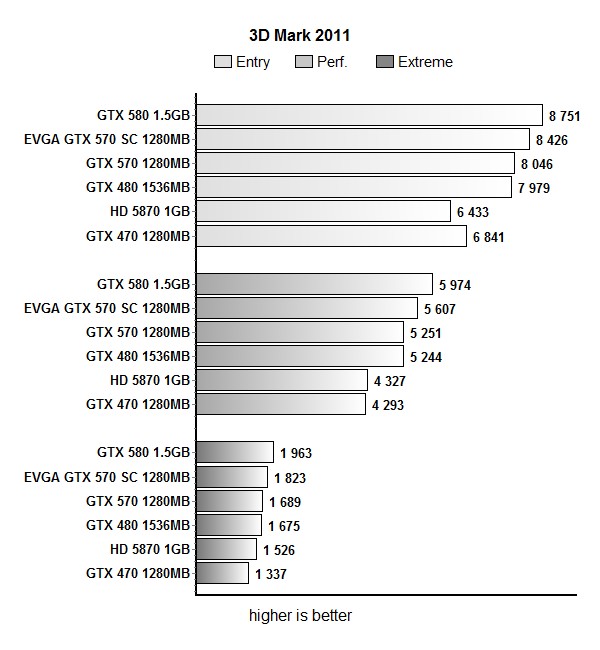
3DMark Vantage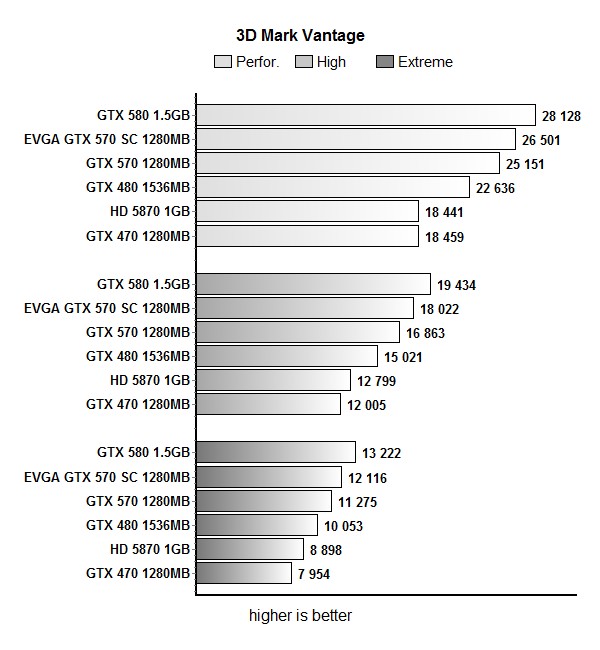
Aliens vs Predator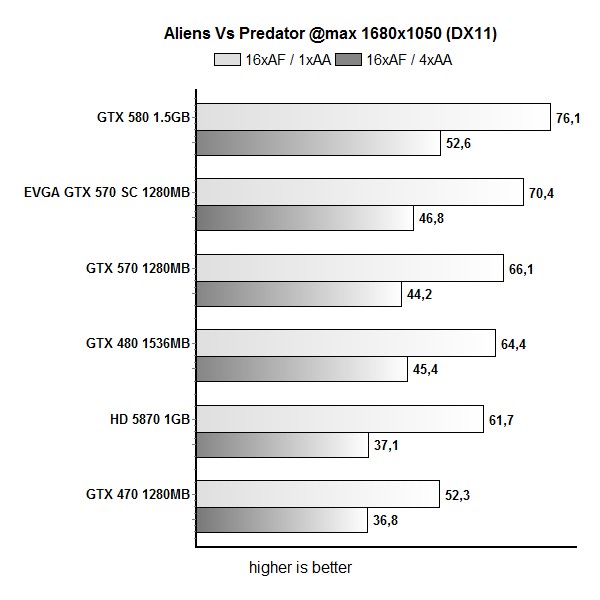
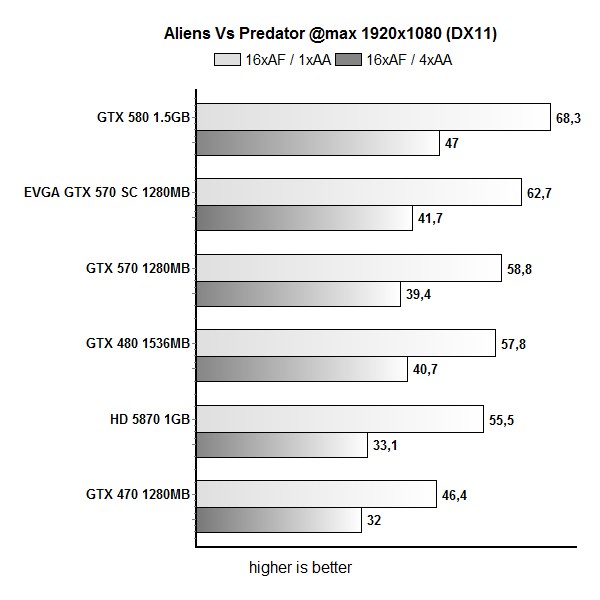

Metro 2033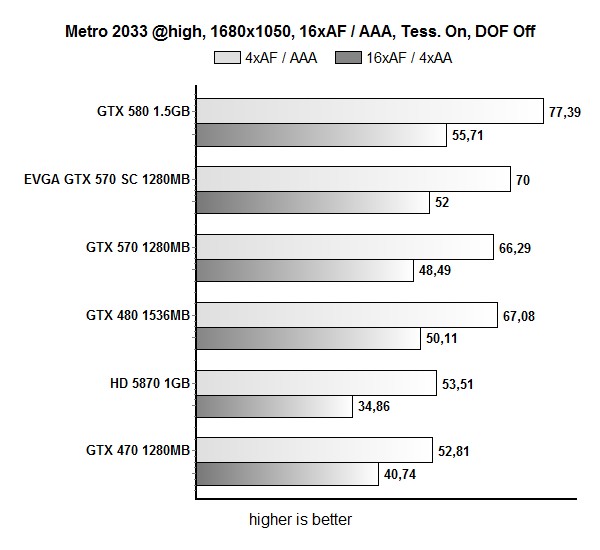
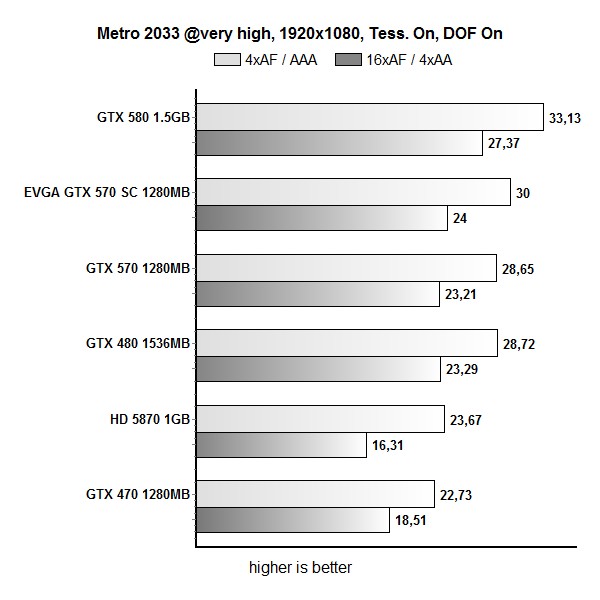
Dirt2
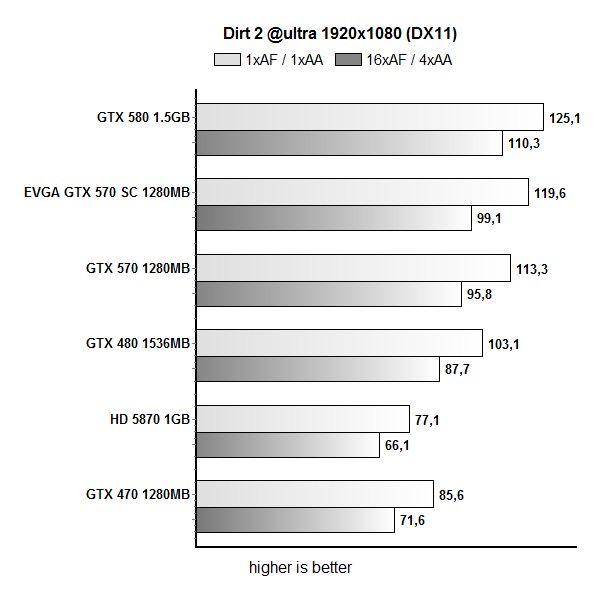
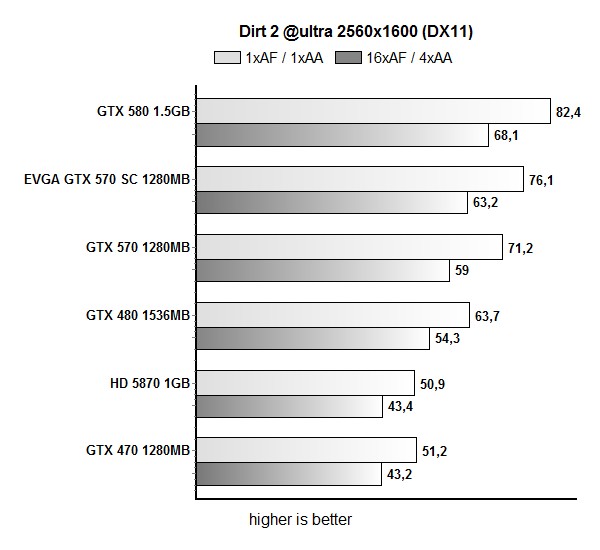
Unigine Heaven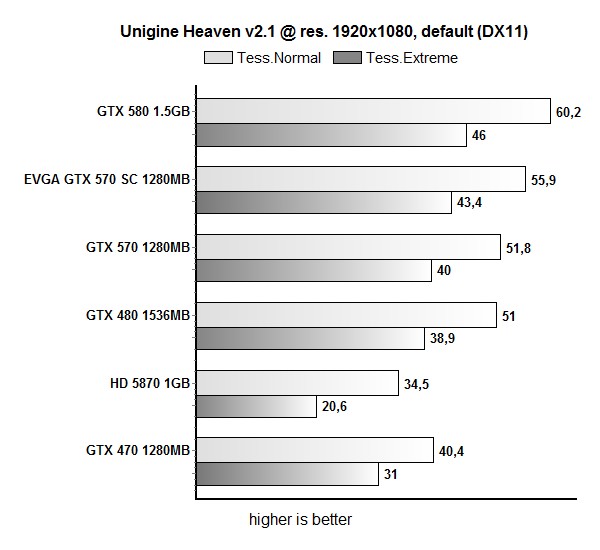
TessMark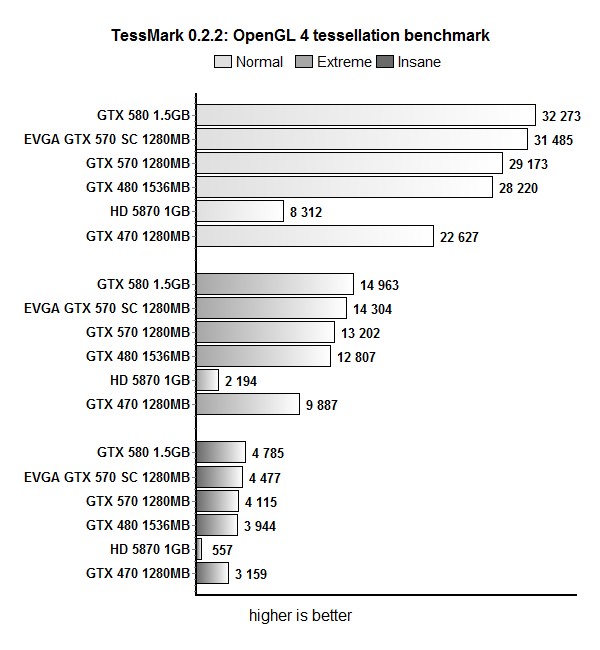
Power Consumption and Thermals
To improve performance/watt, GTX 580/570 GPUs were re-engineered down to the transistor level. To increase the GPU`s power efficiency, a very large percentage of transistors on the chip were modified.
The fan isn’t too loud during intensive gaming and we can finally say that we’re pleased with the noise levels. FurMark temperatures were at 85 degrees Celsius, but the fan stays quiet throughout the test.

Conclusion
Just in time for the holidays Nvidia came out with the GTX 570, a second in line GF110 GPU based card. It is important to note that GF110 offers superior power/performance ratio and most certainly better acoustic properties compared to the GF100, which is used on the GTX 480.
Nvidia kept power consumption and thermals in check, although some key components on the GTX 570 were sacrificed in order to achieve an attractive price point and comfortably fit the card into current product lines. The GTX 570 ships with 480 CUDA cores and 15 PolyMorph Engines, while GTX 580 sports 512 CUDA cores and 16 PolyMorph Engines.
The new card is designed for gamers who want to play their games at maximum graphics settings and screen resolutions but are not quite willing or capable of splashing out a small fortune for a graphics card. The GTX 570 maintains the key features found in the GTX 580, but comes in a more affordable package. Suggested etail price for the Geforce GTX 570 is $329 (without VAT), €349 (including VAT), £289 (including VAT), but we will likely find retail boards from Nvida`s partners at various price points.
Clock speeds for the GTX 570 are 732MHz for the GPU, 1464MHz for shader proseccors (or CUDA cores). The memory is clocked at 3800MHz. The Geforce GTX 570 measures 10.5 inches in length and is powered via two 6-pin power connectors.
Display outputs include two dual-link DVI and one mini-HDMI (mini-HDMI cable might be bundled by partners and if not it will cost you much more than a standard full size HDMI that you use for your HD TV).
In addition to delivering excellent performance, the GTX 570 also offers gamers features like CUDA, PhysX, Nvidia 3D Vision / 3D Vision Surround. As a result of improvements on the thermal/power side, the GTX 570 cooler runs at low sound levels even during intensive gaming.
Up until recently, the GTX 480 was the fastest Nvidia card. Thankfully, the card was dethroned by the GTX 580 as well as the new GTX 570. Even better is the fact that the GTX 570 can be found priced lower than the GTX 480.
All in all, the watt-to-performance ratio is simply great, the card runs quietly even in intensive gaming scenarios and the card packs one mean punch. With that in mind, we would recommend the GTX 570 in a flash.



